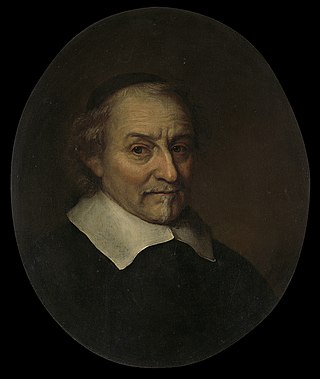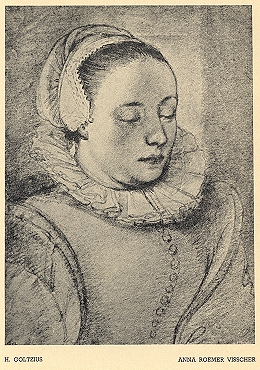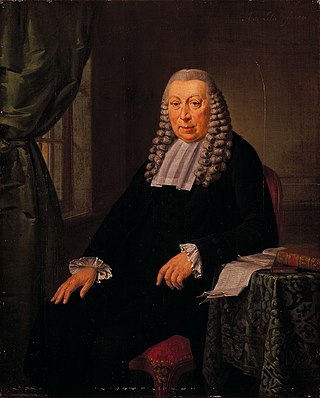
Sir Constantijn Huygens, Lord of Zuilichem, was a Dutch Golden Age poet and composer. He was also secretary to two Princes of Orange: Frederick Henry and William II, and the father of the scientist Christiaan Huygens.

Pieter Corneliszoon Hooft - Knight in the Order of Saint Michael - was a Dutch historian, poet and playwright who lived during the Dutch Golden Age in literature.

Anthony van Diemen was a Dutch colonial governor.

Joost van den Vondel was a Dutch playwright, poet, literary translator and writer. He is generally regarded as the greatest writer in the Dutch language as well as an important figure in the history of Western literature. In his native country, Vondel is often called the “Prince of Poets” and the Dutch language is sometimes referred to as “the language of Vondel”. His oeuvre consists of 33 plays, a large number of poems in different genres and forms, an epic poem and many translations of predominantly classical literature. Vondel lived in the Dutch Republic during the Eighty Years' War and became the leading literary figure of the Dutch Golden Age.
Dutch language literature comprises all writings of literary merit written through the ages in the Dutch language, a language which currently has around 23 million native speakers. Dutch-language literature is the product of the Netherlands, Belgium, Suriname, the Netherlands Antilles and of formerly Dutch-speaking regions, such as French Flanders, South Africa, and Indonesia. The Dutch East Indies, as Indonesia was called under Dutch colonization, spawned a separate subsection in Dutch-language literature. Conversely, Dutch-language literature sometimes was and is produced by people originally from abroad who came to live in Dutch-speaking regions, such as Anne Frank and Kader Abdolah. In its earliest stages, Dutch-language literature is defined as those pieces of literary merit written in one of the Dutch dialects of the Low Countries. Before the 17th century, there was no unified standard language; the dialects that are considered Dutch evolved from Old Frankish. A separate Afrikaans literature started to emerge during the 19th century, and it shares the same literary roots as contemporary Dutch, as Afrikaans evolved from 17th-century Dutch. The term Dutch literature may either indicate in a narrow sense literature from the Netherlands, or alternatively Dutch-language literature.

Roemer Pieterszoon Visscher was a successful Dutch merchant, the first Dutch underwriter and writer of the Dutch Golden Age.

Gerbrand Adriaenszoon Bredero was a Dutch poet and playwright in the period known as the Dutch Golden Age.

Maria Tesselschade Roemers Visscher, also called Maria Tesselschade Roemersdochter Visscher or Tesselschade was a Dutch poet and glass engraver.

Muiden Castle is a castle in the Netherlands, located at the mouth of the Vecht river, some 15 kilometers southeast of Amsterdam, in Muiden, where it flows into what used to be the Zuiderzee. It is one of the better known castles in the Netherlands and featured in many television shows set in the Middle Ages.
Dutch Renaissance and Golden Age literature is the literature written in the Dutch language in the Low Countries from around 1550 to around 1700. This period saw great political and religious changes as the Reformation spread across Northern and Western Europe and the Netherlands fought for independence in the Eighty Years' War.

Anna Roemers Visscher was a Dutch artist, poet, and translator.

Jan Jansz. Vos was a Dutch playwright and poet. A glassmaker by trade, he also played an important role as stage-manager and director of the theatre. He organized, on the mayors' orders, processions and splendid decorated floats, which sometimes drew disapproval, criticism, and derision.

Catharina Pietersdr Hooft was a woman of the Dutch Golden Age. She became famous at a very early age, when she was painted by Frans Hals.
Visscher is a Dutch occupational surname. Visscher is an archaic spelling of Dutch visser meaning "fisherman". Varianta are Visschers and De Visscher. The latter form is now most common in East Flanders. Notable people with the surname include:

Camerata Trajectina is a Dutch early music ensemble.
Johan (Jan) van Brosterhuysen, also spelled "Brosterhuisen" was a Dutch botanist, engraver, writer, and translator. At age 14 he was registered as a gownsman on 3 June 1610 at Leiden University, his native city. His interest was botany, but he was unable to acquire a teaching position in that field and took a position as secretary at Heusden Castle. Having moved to Amersfoort he became interested in architecture, until his college friend Constantijn Huygens got him a position as professor of botany and literature in a newly founded academy in Breda; he was also keeper of the botanical garden. He died in Breda in September 1650.
Francisca Duarte was a Portuguese singer. She was active as a court singer at the court of the governor in the Spanish Netherlands.

Jan, Joan, Joannes or Johan Six van Chandelier was a Dutch Golden Age poet from Amsterdam who travelled to Spa, France, Spain, Italy, and England. His collected works were republished in 1991.

Hendrik Daniëlszoon Hooft, Ambachtsheer of Urk and Emmeloord was a Dutch politician during the Patriottentijd.

River Landscape is a 1642 landscape painting by the Dutch artist Salomon van Ruysdael. It is now in the Musée des Beaux-Arts of Strasbourg, France. Its inventory numbers is 277.















